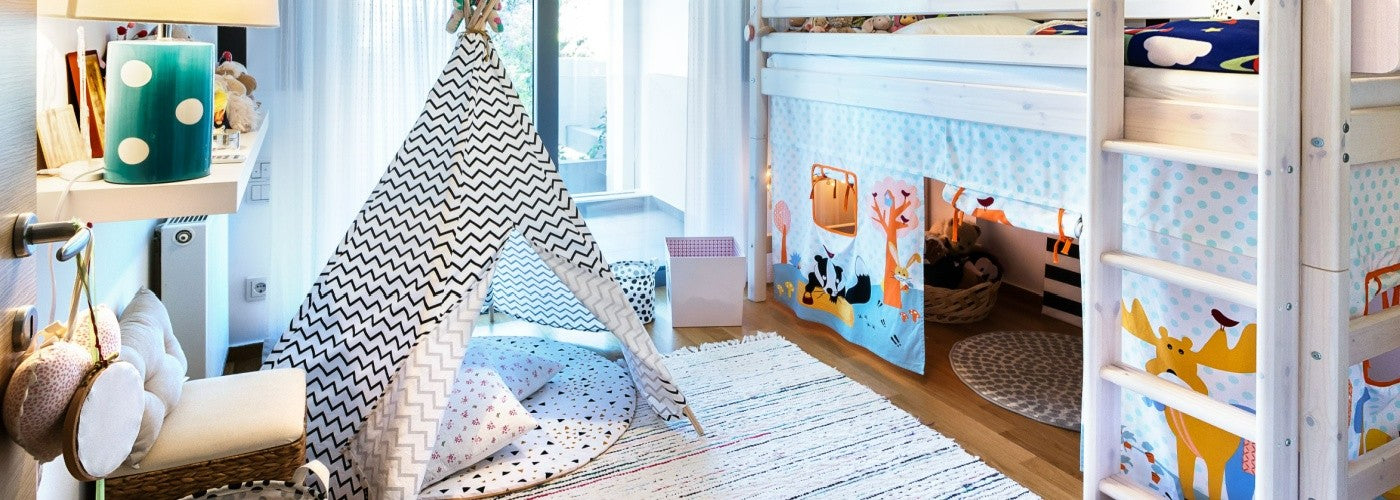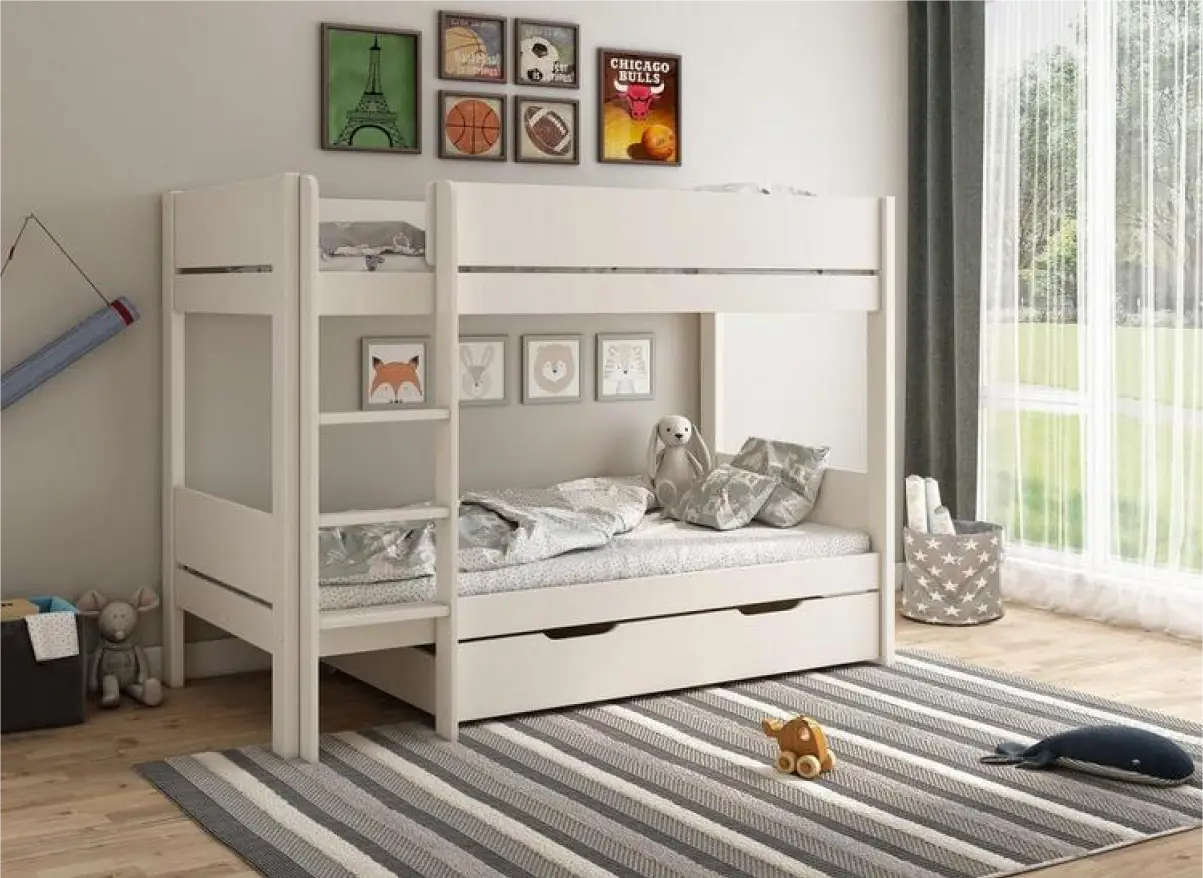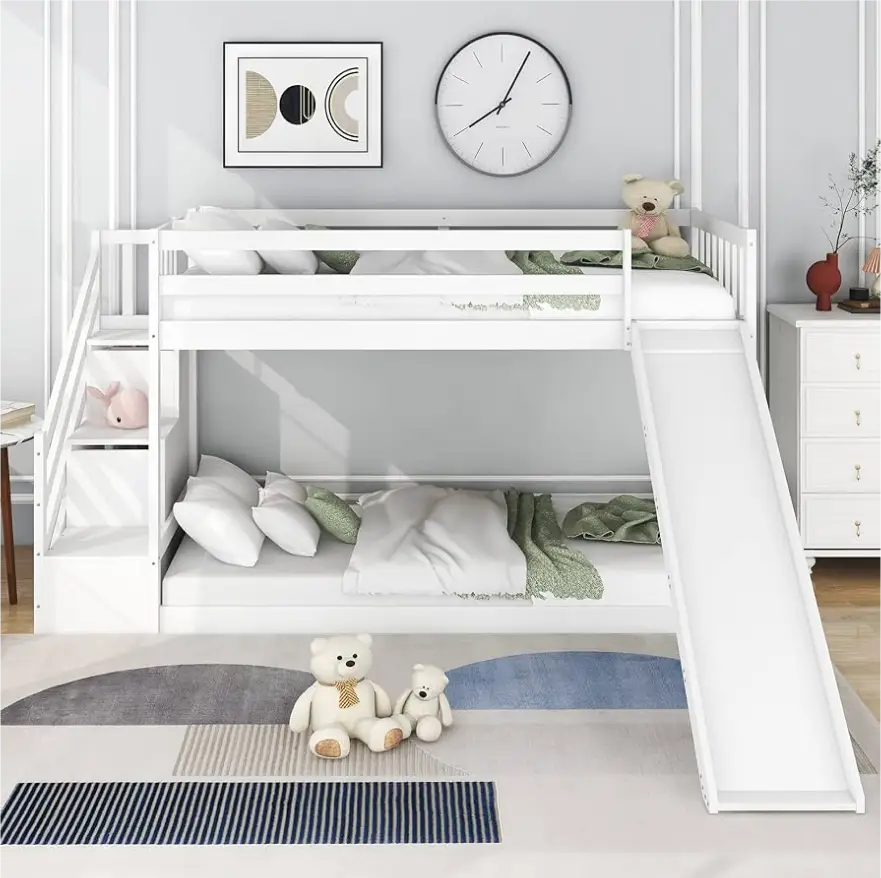When picking a new bed for your child, you're faced with a huge range of options. First, you must consider the floor space available, your child's age, what you both want from a bed and how they'll use it as they grow up; will they need a pull-out desk, for instance? So, a lot!
During your search, you're likely to have come across mid-sleepers and high-sleeper beds, and you could be a little confused as to what the difference is between the two models.
Fortunately, Bunk Beds have compiled this handy guide to help you decide which bed frame is best for your child's bedroom.
What is a mid-sleeper bed?
Mid-sleeper beds – often called cabin beds – are raised off the ground to allow for storage space or a play area underneath the bed. A mid-sleeper bed typically has built-in storage drawers and shelves in the bed frame underneath the raised bed, providing additional storage for clothes, bedding, blankets and more.
Mid-sleepers feature small ladders so younger children can reach the bed from the ground.
A cabin bed is hugely popular for children as they enjoy a higher sleeping area as well as having a private area underneath to play and relax.
What is a high-sleeper bed?
A high-sleeper bed frame is just like a mid-sleeper bed but higher off the ground. These types of beds are often called loft beds as they're so much higher.
Like mid-sleeper beds, they can feature storage and a space to relax and play underneath the raised bed.
However, with high-sleeper beds, there is much more space beneath the bed, giving families more room to store essentials. High sleeper beds may allow for a much greater choice in terms of design, with many options featuring a desk and a seating area for your child.
This gives them a place to relax and somewhere to get their homework done, and possibly create a gaming setup for older kids.
What are the main differences between high and mid-sleeper beds?
Of course, the main difference between mid-sleepers and high-sleeper beds is the height.
While both are raised off the ground, creating space beneath for storage and play, a mid-sleeper bed is not as high as a high-sleeper bed.
A mid-sleeper bed frame features just enough space for small children to access and play underneath, with several drawers and storage areas to house essentials.
A loft bed – a high-sleeper bed – has a lot more space, allowing older children and adults to access the space underneath. High-sleeper beds can also fit wardrobes into their bed frame, providing storage for larger items like coats, shirts and dresses – ideal for the teenage years as children grow and their clothes take up more space.
How high is a mid-sleeper bed?
The standard height of a mid-sleeper bed varies based on design, but they're generally between 110cm and 140cm tall. In comparison, a traditional single bed can be between 32cm and 35cm high (mattress not included).
How high is a high-sleeper bed?
A high-sleeper bed is, traditionally, designed much taller than a mid-sleeper, and is usually between 170cm and 200cm tall. This, of course, could be different based on design but the average size is between these two figures.
What age can children sleep in mid and high-sleeper beds?
We recommend only children aged six and above should use a mid or high-sleeper bed.
This is because both beds, despite being designed at different heights, require the use of a ladder to access the bed. For children younger than six years of age, a ladder can pose safety risks – especially on a high-sleeper bed which is a lot taller.
Some beds feature a set of stairs rather than a ladder, but we still recommend these beds for children once they're six.
From six, these beds are useful for children right through their teenage years. With desks, relaxing seats and ample storage, they're ideal for growing children.
How to make mid and high-sleeper beds safe
Are high and mid-sleeper beds safe? Absolutely! Especially if you follow these steps to ensure your little ones are as safe as possible at all times.
- Follow the age limit recommendation – It's important that you follow our age limit recommendation for mid and high-sleeper beds, so your child isn't at risk of injury.
- Don't play on the bed – You should remind your child that the bed is for sleeping and not bouncing, jumping or playing. A raised bed poses a safety risk if children are fooling around, so they should know early on not to play up there.
- Only one person at all times – Higher beds are fun and exciting for young children, but only one at a time should be using them. If there are two children on the bed, for example, one will likely be close to the ladder, posing a risk of falling.
- Ensure safety rail is in place – Never ignore a safety rail on raised beds. They prevent children from rolling off while they sleep.
- Check head height – Before purchasing the bed, measure your kid's bedroom and ensure there's enough head space. You don't want them bumping their head every time they wake up!
- Install a carpet or rug – Finally, ensure the bedroom has a carpet or a rug so your child does have something soft to fall on if they do have an accident. If they slip off the ladder, a soft, cushioning material beneath can help to limit injury.
What to consider when choosing between high and mid-sleeper beds
Before purchasing a mid-sleeper or high-sleeper bed, there are a few things you must consider.
Measure your child's bedroom
The first thing you must do is check what bed will actually fit in your child's bedroom. Many people will just assume the bed they like will fit into their space, but high-sleeper beds, in particular, can be quite tall and may restrict head space.
Carefully measure the height and width of the bedroom before choosing a bed.
Stairs or a ladder?
When you imagine a raised bed, your brain will likely automatically think about a ladder, but many designs feature stairs.
So, the choice is yours. Would you prefer a high or mid-sleeper with a ladder or with stairs? Space may dictate your decision, but it's a consideration before purchasing.
What will you use the space underneath for?
Try to think about what your child likes to do in their free time. Are they an imaginative player that loves a den or are they into video games?
The space beneath the bed on both mid and high-sleepers offers plenty of opportunities to be creative. So, will your child play there or do they need a desk to complete homework and play online games with friends?
How old is your child, and what are they likely going to need?
Next, consider how old your child is before purchasing their new bed. You may prefer a mid-sleeper but if your child is approaching their teenage years, they'll likely need more storage space and a desk to complete homework – warranting a high-sleeper bed.
Their clothes are much bigger than a young child too, so they'll need that extra storage space, especially in smaller bedrooms. A built-in wardrobe could be ideal for their age, as they become more fashion-conscious.
Also, is your child a big gamer? This is your opportunity to provide them with their very own gaming setup underneath their bed without losing valuable floor space.
Mattress depth
The final consideration is the size of the mattress you purchase, particularly its depth.
If head height is already limited, you should avoid purchasing a thick mattress, as this will only reduce that space.
Additionally, you should aim to purchase a mattress between 15cm and 18cm in depth so your child isn't sleeping above the safety rails.
Buy high-quality mid or high-sleeper beds
So, you're all set to buy a brand-new mid-sleeper or high-sleeper bed for your little one. But, which one will you choose?
We hope our in-depth guide has helped with your decision-making, but if you still need some more information or advice, you can contact us today and a member of our team will be happy to help.
We have a huge range of mid-sleeper beds and high-sleeper beds that we can talk you through. We can also discuss our price match promise while we have you.





